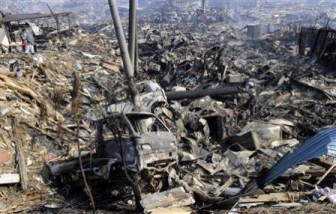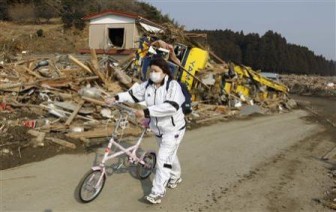FUKUSHIMA, Japan, (Reuters) – Japan fought today to avert a meltdown at three earthquake-crippled nuclear reactors, describing the massive quake and tsunami, which may have killed more than 10,000 people, as the nation’s biggest crisis since World War Two.
The world’s third-largest economy is struggling to respond to a disaster of epic proportions, with more than 1 million without water or power and whole towns wiped off the map.
“The earthquake, tsunami and the nuclear incident have been the biggest crisis Japan has encountered in the 65 years since the end of World War II,” a grim-faced Prime Minister

told a news conference.
“We’re under scrutiny on whether we, the Japanese people, can overcome this crisis.”
As he spoke, officials worked desperately to stop fuel rods in the damaged reactors from overheating, which could in turn melt the container that houses the core, or even explode, releasing radioactive material into the wind.
The government said a building housing a second reactor at the same complex was at risk of exploding after a blast blew the roof off the first the day before. The complex is 240 km (150 miles) north of Tokyo.
Later it said it was pouring seawater into a third reactor to release a buildup of pressure.
The No. 1 reactor, where the roof blew off, is 40 years old and was originally scheduled to go out of commission in February but had its operating licence extended another 10 years. But Kan said the crisis was not another Chernobyl, referring to the 1986 nuclear disaster.

“Radiation has been released in the air, but there are no reports that a large amount was released,” Jiji news agency quoted him as saying. “This is fundamentally different from the Chernobyl accident.”
Nevertheless, France recommended its citizens leave the Tokyo region, citing the risk of further earthquakes and uncertainty about the nuclear plants.
Broadcaster NHK, quoting a police official, said more than 10,000 people may have been killed as the wall of water triggered by Friday’s 8.9-magnitude quake surged across the coastline, reducing whole towns to rubble.

Almost two million households were without power in the freezing north, the government said. There were about 1.4 million without running water.
Kyodo news agency said about 300,000 people were evacuated nationwide, many seeking refuge in shelters, wrapped in blankets, some clutching each other sobbing.
Authorities have set up a 20-km (12-mile) exclusion zone around the Fukushima Daiichi plant and a 10 km (6 miles) zone around another nuclear facility close by. Around 140,000 people have been moved from the area, while authorities prepared to distribute iodine to protect people from radioactive exposure.

The nuclear accident, the worst since Chernobyl, sparked criticism that authorities were ill-prepared for such a massive quake and the threat that could pose to the country’s nuclear power industry.
Chief Cabinet Secretary Yukio Edano said there might have been a partial meltdown of the fuel rods at the No. 1 reactor at Fukushima. Engineers were pumping in seawater, trying to prevent the same happening at the No. 3 reactor, he said in apparent acknowledgement they had moved too slowly on Saturday.

“Unlike the No.1 reactor, we ventilated and injected water at an early stage,” Edano told a news briefing.
The No. 3 reactor uses a mixed-oxide fuel which contains plutonium, but plant operator Tokyo Electric Power Co (TEPCO) said it did not present unusual problems.
Asked if fuel rods were partially melting in the No. 1 reactor, Edano said: “There is that possibility. We cannot confirm this because it is in the reactor. But we are dealing with it under that assumption .”
He said fuel rods may have partially deformed at the No. 3 reactor but a meltdown was unlikely to have occurred.

“The use of seawater means they have run out of options,” said David Lochbaum, director of the Union of Concerned Scientists Nuclear Safety Project.
TEPCO said radiation levels around the Fukushima Daiichi plant had risen above the safety limit but that it did not mean an “immediate threat” to human health.
Edano said there was a risk of an explosion at the building housing the No. 3 reactor, but that it was unlikely to affect the reactor core container.
The wind over the plant would continue blowing from the south, which could affect residents north of the facility, an official at Japan’s Meteorological Agency said.

The disaster prompted an angry response from an anti-nuclear energy NGO in Japan which said it should have been foreseen.
“A nuclear disaster which the promoters of nuclear power in Japan said wouldn’t happen is in progress,” the Citizens’ Nuclear Information Centre said. “It is occurring as a result of an earthquake that they said would not happen.”
SEARCH FOR THE MISSING
Kan said food, water and other necessities such as blankets were being delivered by vehicles but because of damage to roads, authorities were considering air and sea transport. He also said the government was preparing to double the number of troops mobilised to 100,000.
Thousands spent another freezing night huddled in blankets over heaters n emergency shelters along the northeastern coast, a scene of devastation after the quake sent a 10-metre (33-foot) wave surging through towns and cities in the Miyagi region, including its main coastal city of Sendai.

In one of the heavily hit areas, Rikuzentakata, a city close to the coast, more than 1,000 people took refuge in a school high on a hill. Some were talking with friends and family around a stove. The radio was giving updates. On the walls were posters where names of survivors at the shelter were listed.
Some were standing in front of the lists, weeping.
Kyodo news agency reported there had been no contact with around 10,000 people in one town, more than half its population.
A Japanese official said there were 190 people within a 10-km radius of the nuclear plant when radiation levels rose and 22 people have been confirmed to have suffered contamination. Workers in protective clothing were scanning people arriving at evacuation centres for radioactive exposure.
GOVERNMENT CRITICISED
The government, in power less than two years and which had already been struggling to push policy through a deeply divided parliament, came under criticism for its handling of the disaster.

“Crisis management is incoherent,” blared a headline in the Asahi newspaper, saying information and instructions to expand the evacuation area around the troubled plant were too slow.
There has been a proposal of an extra budget to help pay for the huge cost of recovery.
The Bank of Japan is expected to pledge on Monday to supply as much money as needed to prevent the disaster from destabilising markets and its banking system. It is also expected to signal its readiness to ease monetary policy further if the damage from the worst quake since records began in Japan 140 years ago threatens a fragile economic recovery.
Before news of the problem with reactor No. 3, the U.N. nuclear safety agency said the plant accident was less serious than both the Three Mile Island accident in 1979 and Chernobyl.
An official at the agency said it rated the incident a 4 according to the International Nuclear and Radiological Event Scale (INES). Three Mile Island was rated 5 while Chernobyl was rated 7 on the 1 to 7 scale.
The earthquake was the fifth most powerful to hit the world in the past century.





